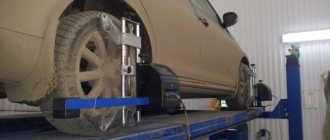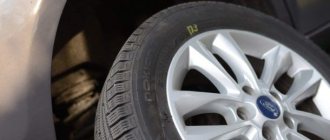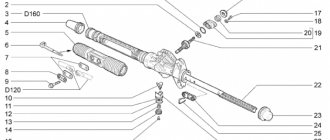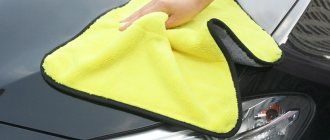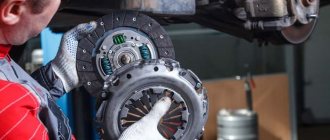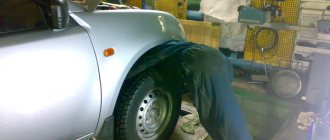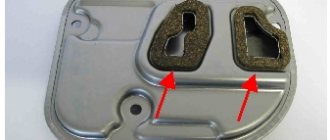It may seem like a daunting task to try to diagnose a car's steering system or suspension problems, but if you do it systematically, you have a good chance of finding the correct cause of such problems. We have identified the symptom of the steering wheel pulling to a certain direction, and this definitely means a problem with the suspension and/or steering, and let's look at the probable reasons why the steering wheel pulls to the side in the list below!
Most of the reasons that the car is steering to the right can be determined independently by other characteristic associated symptoms, however, sometimes a particular malfunction can only be determined by a qualified auto mechanic.
It is very important, before starting to replace certain parts and components of the machine, to check all the fastenings of the nuts and bolts of the suspension elements to make sure that the steering wheel is not pulled to the side due to simple looseness of the parts. In addition, before trying to look for the cause, you need to establish the stability of the malfunction - it often happens that the car is pulled to the side due to the ruts of the road, and in this case, the main feature of the steering wheel being pulled for this reason will be that it will not only be pulled in one direction, but in different directions - depending on which side of our trajectory this track is located.
Try driving on different roads, let go of the steering wheel and carefully observe whether the car always starts to pull in one direction. In addition, check whether the released steering wheel turns in the same direction on its own or whether it remains in the same position.
Incorrect tire pressure
The most common problem that causes a car to deviate from a straight path while driving is incorrect tire pressure. Quite often, when installing tires, drivers neglect to check whether the tire pressure meets the standards for their particular car. If one of the wheels has a lower pressure than the other, this will cause the car to tilt to the side when driving.
For example: If the left front tire is significantly lower than the right one, the car will lean to the left when driving.
In addition to the danger of the car spontaneously deflecting while driving, insufficient (or excessive) tire pressure will lead to another serious problem - their rapid wear. Accordingly, you should not neglect checking the pressure, otherwise a new set of tires may become unusable in just a few days.
Please note: Nowadays, almost all gas stations have pumps that allow you not only to check tire pressure, but also to inflate them for free.
Why does a car pull to the side and is it dangerous?
A vehicle pulling to the right when driving quietly is a fairly common problem with used cars. In such circumstances, the driver is forced to periodically steer in order to maintain a straight direction. At some points, this requires significant effort. You can’t relax here for a split second, because literally in one moment you can find yourself in another lane or ditch. It is dangerous to delay the restoration of directional stability.
Unauthorized departure of a moving vehicle from a flat trajectory may be a consequence of the following shortcomings:
- malfunctions of steering system elements;
- unevenly inflated tires;
- failures in brake response;
- uneven wear of the front axle tire treads;
- wear of the chassis.
The most popular sources of impaired controllability of vehicles are named. But when it practically blows away after slowing down, it’s the brakes that are to blame.
A clear symptom of the “disease” will be a noticeable deviation of course to the right on a perfectly flat road without additional maneuvers. Here it’s time to get worried and urgently start looking for reasons that are important to eliminate in the coming days, or better yet, hours.
It is important to remember that inaction risks losing control of the vehicle at any time - on a flat road, when accelerating/decelerating, or while performing any maneuvers.
Incorrectly installed directional rubber
Recently, so-called directional rubber has been gaining popularity. These are tires that have a special tread pattern that allows the car to stand more firmly on the road. These tires have arrows that indicate the direction of travel. They must be installed in accordance with these arrows.
If you install the directional tires incorrectly, for example, on the wrong side, this will cause the car to pull to the left or right while driving. In addition, handling will noticeably deteriorate, and tire wear will also increase.
Tire wear
Another reason that can be called quite common is the car spontaneously moving to the side when driving due to uneven wear of the tires. If your car uses tires (or one of the tires) that have previously been used somewhere, it is possible that the tires will have different wear.
In this situation, you need to carefully inspect the tires located on the side of the car towards which it tilts while driving. Look at the tire tread pattern; it may be a little more worn than on other wheels.
Installation of different tires
The traffic rules of the Russian Federation (and most other countries) expressly prohibit the installation of tires with different tread patterns on car wheels. However, many drivers neglect this rule, as a result of which problems arise with the car while driving.
When installing tires with different tread patterns on a car, the grip on the road will be different on different wheels. Accordingly, the car will begin to spontaneously pull while driving in the direction where the road grip is higher.
Please note: If for one reason or another you have to use tires with different tread patterns, try to use the same tires on the same axle, this will reduce the likelihood of problems.
Chassis and suspension malfunctions
When mechanical problems occur, the car pulls to the side much more than from the difference in tire pressure or different tread heights. The following faults cause the vehicle to be driven away:
- Worn tie rod ends. The ball pin does not turn well in the hinge, and sometimes it simply jams. A clear sign is that the steering wheel does not return to its original position on its own, the car continues to move in an arc.
- One of the steering rods was bent as a result of the impact and became several millimeters shorter. The toe angle of the front wheels is disrupted, tire wear on the affected side is accelerated, and the car is driven in the appropriate direction.
- The ball joint is stuck. The pin rotates around its own axis with great difficulty and does not allow the wheels to turn freely. At the last stage of wear, the hinge emits a loud creaking sound - a harbinger of final failure.
- The separator of one of the wheel bearings is destroyed. The balls scattered and ground into metal shavings, blocking the rotation of the hub. The car pulls towards the jammed wheel.
- After repairing the suspension, the alignment procedure was performed incorrectly or not done at all.
Brake problems
A problem that is only indirectly related to the procedure for changing wheels. If there is jamming of the brake mechanisms of the left or right front wheel, the car may be pulled to the side.
The reason this problem manifests itself precisely when replacing tires is that summer tires are often narrower than winter tires. Accordingly, when switching from summer tires to winter tires, a malfunction of the brake mechanisms may appear. In such a situation, you need to diagnose the cause of the brake malfunction and make repairs. Often, such a problem is “cured” by replacing the cylinders.
The car pulls to the side - reasons:
- First, you should check the tire pressure. You can do this procedure yourself using a pressure gauge. The fact is that the difference in pressure in the right and left wheels is often the main reason for the car to pull to the side. The same will happen with excess or insufficient pressure. On average, the normal pressure for a passenger car is 2.1 atmospheres. You can get more accurate information by reading your machine's owner's manual.
- The second reason - just like the first - belongs to the category “due to inattention”. To do this, just compare the tire models installed on the front and rear . On the front axle, as well as on the rear, it is not allowed to use different tires, as well as tires that are worn unevenly on the right and left.
- Number three - the most common problem - the wheel alignment is not adjusted . We changed the suspension, replaced the tires - don’t forget to go for a wheel alignment adjustment.
- The fourth reason lies in everything related to brakes . Unevenly worn brake pads, airy brake circuits, leaking brake fluid, soured guides or brake cylinders, uneven wear of brake discs - these are the main reasons associated with the brake system.
- Poor quality tires and uneven wear. If this problem occurs, you can try swapping the right and left wheels; there is a high probability that this will be enough for a comfortable ride. If, after replacing the wheels, the car begins to pull in the other direction, then it’s time to go to a tire shop. Ask to place the defective wheel backwards, that is, so that the outer side becomes the inner side, or vice versa. If you have directional tires, you will need to swap the rear wheels with the front ones.
- Curved rim In this case, you will need to roll out and straighten the rim.
Here are the main problems why your car may be pulling to one side. Now let's figure out how to deal with this problem .
- The difference in tire pressure can be easily eliminated using a pressure gauge and a pump . If you do not have such devices, you should drive to the nearest gas station. Almost any gas station has a pump with a built-in pressure gauge that will equalize the pressure in all four wheels.
- Different tire treads on the same axle must be replaced. The rubber must not differ in tread, manufacturer, or model!
- If you have made any manipulations with the tires of the car or its suspension, be sure to adjust the wheel alignment . At the same time, you should not carry out this procedure in your garage; contact qualified specialists with good computer equipment (Autopride - high-quality diagnostics and professional car repairs in St. Petersburg). An incorrectly adjusted wheel alignment can lead to very rapid wear of new expensive tires, so you should not delay this procedure.
- Problems related to the brake system can be fixed with your own hands , but you should not do this if you have absolutely no knowledge of cars. Experimenting with your brakes could cost you your life. Therefore, if you are far from all this, entrust the work to specialists.
- If the malfunction lies in uneven wear of the brake pads or brake discs, remember - these spare parts are replaced only in pairs , both on the right and on the left!
- Brake cylinders and guides with visible signs of wear are not ground ! They need to be changed.
- An airy brake circuit can also cause the car to pull to the side , this is especially noticeable when the brakes heat up. If you decide to bleed the brake system, replace the brake fluid immediately. Remember, it changes at least once every two years.
- All brake fluid leaks must be repaired immediately , otherwise the car will not only pull to one side, but you risk being left without brakes.
- If you come across low-quality tires and after all the manipulations with the wheels the problem is not resolved, you may need to replace it . Old tires can be placed on the spare wheel.
- If the brake disc is bent, you should contact a car repair shop, where they can roll it out and at the same time, if necessary, carry out balancing.
Incorrectly performed wheel alignment
According to the recommendations of automobile manufacturers, a wheel alignment is required with each seasonal replacement of tires. This is especially important when switching from summer tires to winter ones, which have more grip.
Also, problems with wheel alignment can arise after replacing consumables in the car's suspension or after a complete suspension overhaul. You can perform wheel alignment at almost any tire center. It is important to do this as soon as possible, since improper wheel alignment greatly affects the rate of tire wear.
( 450 votes, average: 4.54 out of 5)
How to find out the production date of a tire?
Is it possible to ride on tires if the studs have fallen out?
